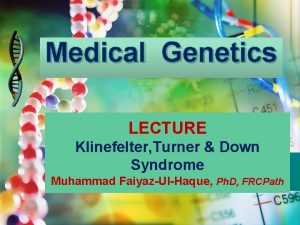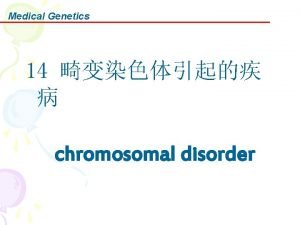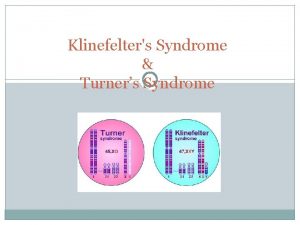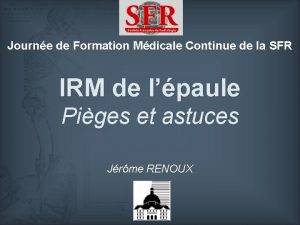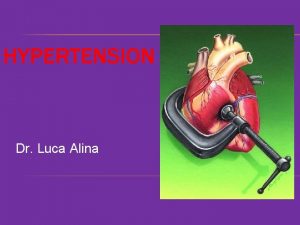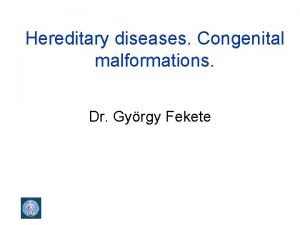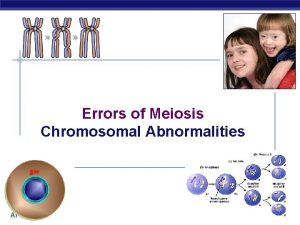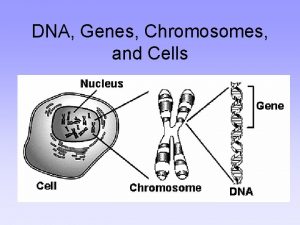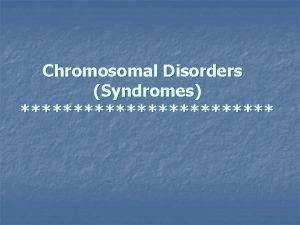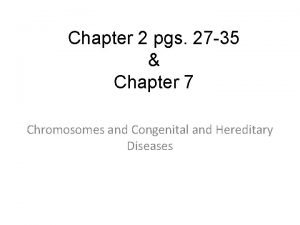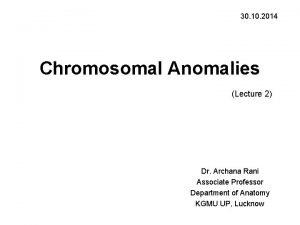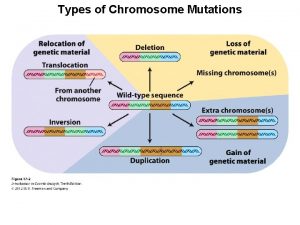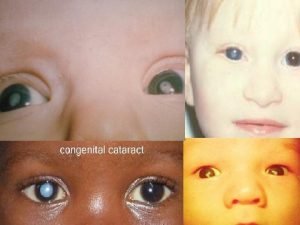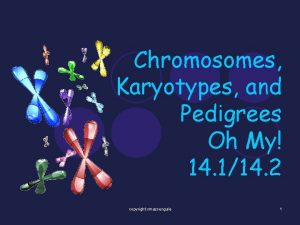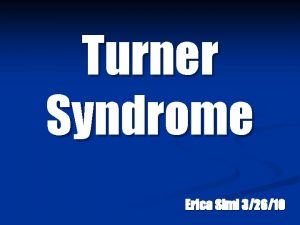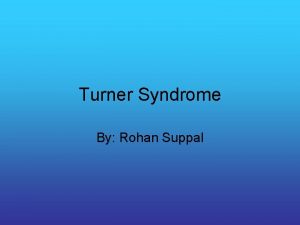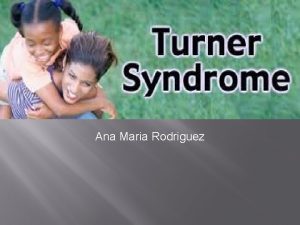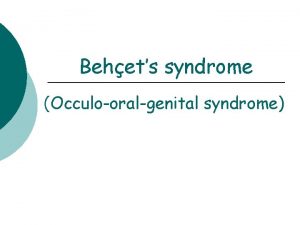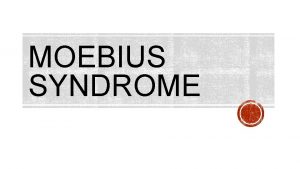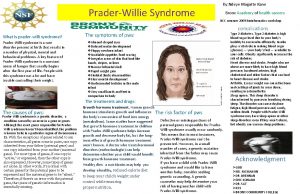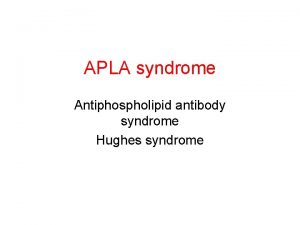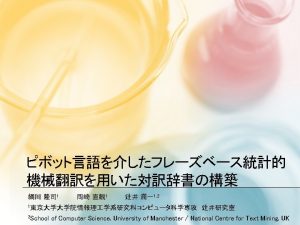Turner Syndrome Presentation to TCGI Conference 2008 Turner
















- Slides: 16

Turner Syndrome Presentation to TCGI Conference 2008

Turner Syndrome o Occurrence 1/2000 – 1/2500 (Rosenfeld 1994) o Characterised: primarily by short stature 95%o o 100% Prenatal or early postnatal premature ovarian failure (gonadal dygenesis) Physical features Associated problems Studies by Stanhope & Fry 1995: intelligence distribution same as general population

Diagnosis o Prenatal u/s – fluid neck lymphatic system o Birth: characteristic features oedema hands/feet, cardic cond chromosomes o Childhood: short stature cardiac conditions, speech/hearing o Adolescence: no pubertal spurt, no sexual development o Adulthood: failure to menstruate, infertility, premature menopause (have some ovarian function to enter spontaneous puberty)

Chromosome Analysis o Turner syndrome occurs when one of the two X chromosomes is missing, giving 45 X instead of 46 XX o 50% have 45 X in all cells o 20% have mosaic pattern: some cells will have 46 XX, other cells 45 X o 30% have 46 XX where various rearrangements of the 2 nd X, ie ring shape, short p long q arm of X

Growth o Childhood Growth: n n Grow at normal rate for 2 -3 years After 3 -4 years growth rate decreases o Adolescent Growth n n n No pubertal spurt: ovarian failure – no oestrogen TS girls continue to grow late teens Mean final height 139 -147 cm (Ranke 1994)

Ovarian Failure o 14 -16 weeks in utero ovaries develop normally o Decrease in oxytes elements of connective tissue (streaks) begin to occupy ovaries o Wide variation n 10%-20% spontaneous pubertal development 2%-5% spontaneous menses Most not fertile occasional pregnancies have occurred – mosaic type

Key Issue Growth Hormone o Allows girl grow similar to peers o Major positive factor o Ranke suggests from his studies n n 7 year old untreated average 107 cm which is 13 cm shorter than normal mean. On GH, height should improve by 9 cm. 13 year old untreated average 25 cm shorter. On GH, should give height within 4 cm of normal range.

Growth Hormone o Children with TS have a growth deficiency but not a hormone deficiency and therefore have some lack of sensitivity to the hormone. o Growth Hormone Stim Tests normal o Doses higher than those used in GHD o GH is manufactured by recombinant DNA technology to produce a sequence identical to human GH

Growth o GH is given for a few years o Many studies to determine optimal age to commence and discontinue GH o Influence of MPH o GH d/c epiphyes closed – growth complete o Bone Age o GH does improve final height (7 cm)

Management o Common Tests / Clinic Visits o IGF 1 / IGFBP 3 monitor growth o Auxology o Blood pressure o TFTs o LHFSH o Renal o Bone age o Audiology

Optimal Management o Coarctation of aorta usually presents in infancy – surgery o Aortic stenosis less common - surgery o Bicuspid aortic valve 13%-34% - Echo Surveillance & endocarditis prophylaxis o Cardiac Referral Echocardiography at diagnosis o Re-evaluate 10 years o Reassessment – adult transfer

Optimal Management o MRI magnetic resonance angiography be used in addition to echocardiography to evaluate cvs o Advice re pregnancy and exercise where cardiac condition present o Yearly blood pressure

Puberty o GH & Oxandrolone at 9 yrs o Pubertal induction o Puberty should not be delayed to promote increased height o Oral Ethinyloestiodiol n n 11 -12 yrs if on GH easily enough 13 yrs optimal (Donaldon et al) o Importance of complying with long-term oestrogen replacement n n Feminization Bone health in adult years

Education Evaluation o Varies o Hearing check middle ear 50%-85% o Conductive deafness – ear infections – decrease with age o Audiological checks o Sensoneural loss 58% Stenberg 1998 o Impaired visuospatial abilities o Some - difficulty maths

Long Term o Continued monitoring of hearing and thyroid function throughout life o Adults monitored for aortic enlargement, hypertension, diabetes and increased cholesterol & triglycerides

Quality of Life Study o Bannink et al (2005) Netherlands o Normal quality of life in those who reached normal height and had age appropriate pubertal devlopment
 2008 2008
2008 2008 Is huntington's disease autosomal or sexlinked
Is huntington's disease autosomal or sexlinked Down turner and klinefelter syndrome
Down turner and klinefelter syndrome Medical
Medical Kleinfelters
Kleinfelters Syndrome de parsonage-turner
Syndrome de parsonage-turner Turner syndrome nails
Turner syndrome nails Turner syndrome
Turner syndrome Turner syndrome is what numerical chromosome disorder?
Turner syndrome is what numerical chromosome disorder? Language
Language Patau syndrome
Patau syndrome Turner syndrome symptoms
Turner syndrome symptoms Isochromosome
Isochromosome Edwards syndrome
Edwards syndrome Pedigrees and karyotypes
Pedigrees and karyotypes Turner syndrome
Turner syndrome The karyotypel has a turner syndrome
The karyotypel has a turner syndrome


